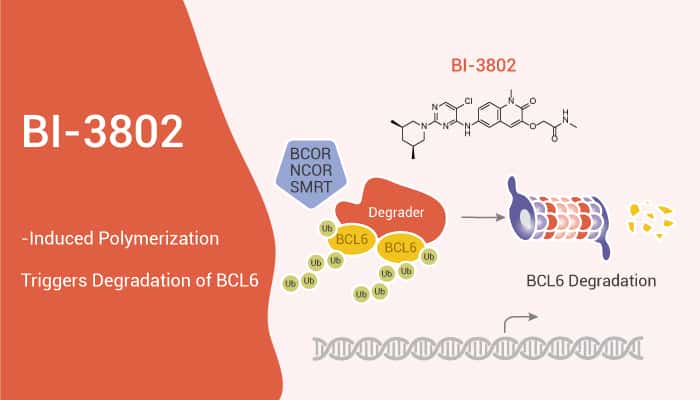PROTAC has been developed to degrade a wide range of clinically relevant targets. These small-molecule degraders engage both the E3 ligase and the target protein to promote the formation of a substrate–drug–ligase ternary complex. Although degraders can show notable efficacy and sustained depletion of targets, some proteins are resistant. For example, BCL6, PROTAC has shown insufficient modulation of the target protein to induce growth inhibition.
Recently, a study from Nature reported the special degradation mechanism of a BCL6 inhibitor, BI-3802.

BCL6 is a promising drug target for non-Hodgkin lymphomas, including diffuse large B cell lymphoma (DLBCL) and follicular lymphoma. Overexpression of BCL6 is sufficient to drive lymphoma development in genetically engineered mice. Treatment with BI-3802 induces rapid ubiquitination and degradation of BCL6, resulting in marked derepression of BCL6 target genes and anti-proliferative effects in DLBCL cell lines. The effects of BI-3802 are comparable to those that result from a genetic knockout and are more pronounced than those induced by non-degrading BCL6 inhibitors (such as BI-3812) or by heterobifunctional BCL6 degraders.
BCL6 was the only protein with significantly decreased abundance after treatment with BI-3802. BI-3802 efficiently depleted chromatin-bound BCL6 and had no effect on BCL6 mRNA. BI-3802 induces the selective degradation of BCL6. Immunofluorescence studies in SuDHL4 cells confirmed that endogenous BCL6 also formed foci after treatment with BI-3802. The drug-induced foci were fully reversible by adding an excess of BI-3812. BI-3802 induces the polymerization of BCL6. The scientists next sought to identify the cellular machinery that is necessary for the BI-3802-induced degradation of BCL6.
Overexpression of wild-type SIAH1 not only enhanced BI-3802-dependent degradation of BCL6 but also reduced the abundance of BCL6 in the absence of the drug, suggesting that SIAH1 has a role in both drug-dependent and endogenous BCL6 degradation. The SIAH1 E3 ligase recognizes a VxP motif on substrate proteins, and this motif is present in residues 249-251 of BCL6. BI-3802 increased the interaction between BCL6 and SIAH1. By contrast, BI-3812 did not influence the interaction between BCL6 and SIAH1, despite BI-3802 and BI-3812 having a comparable affinity to BCL6. Finally, in the presence of BI-3802, SIAH1 colocalized to BCL6 foci in a VxP-motif-dependent manner.
Reference: